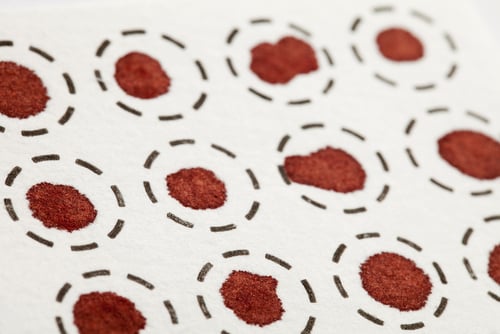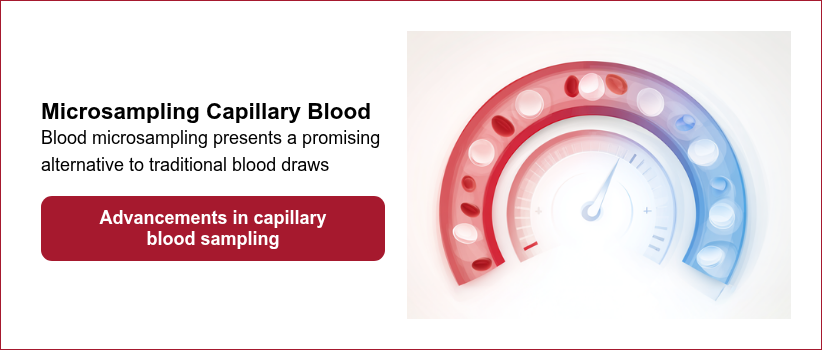Share this
dried blood spots (DBS) and hematocrit bias: a brief introduction
by Neoteryx Microsampling on Mar 22, 2018 6:54:00 AM
Overcoming Hematocrit Bias: Advancements in Blood Microsampling
7:46
For decades, dried blood spot (DBS) cards have served as a useful alternative to painful venipuncture blood draws, especially for infants and other vulnerable patients. With a simple finger or heel stick, DBS made it possible to collect small samples in settings where traditional phlebotomy is challenging or inconvenient.
At the same time, DBS has its own limitations, which have hindered the wider adoption of DBS cards and filter papers in some research and clinical workflows. One of the most frequently discussed challenges is hematocrit bias.

Why Dried Blood Spot Cards Became Popular
DBS cards gained traction because they:
- Require only a small volume of blood, which can be important in vulnerable populations
- Allow samples to dry and be shipped at ambient temperature
- Reduce the need for trained phlebotomists in every collection setting
- Support decentralized or remote collection in clinical trials and research studies
These advantages made DBS an attractive alternative to venipuncture in many scenarios. However, as quantitative methods became more sensitive and expectations for data quality increased, the limitations of traditional DBS cards became more apparent.
What Is Hematocrit and the “Hematocrit Effect” in DBS?
Chief among the limitations of DBS cards is the “hematocrit bias,” also known as the “hematocrit effect.”
Hematocrit is the volume percentage of red blood cells in a blood sample. In simple terms, it describes the proportion of the sample that is red blood cells compared to plasma. This property influences blood viscosity and, in turn, how well blood spreads on the filter paper used in DBS. In general, blood hematocrit has an inverse relationship with spread on the card:
- Blood with a high hematocrit level tends to be more viscous and produces a smaller dried blood spot
- Blood with a low hematocrit level tends to spread more easily and produces a larger dried blood spot
How Hematocrit Bias Affects DBS Sample Quality and Data
When samples with different hematocrit levels are collected on DBS cards, several issues can arise:
- Uneven spreading and distribution: A blood spot that spreads unevenly on a DBS card may contain different concentrations of an analyte at different locations on the card. Two punched discs taken from different parts of the same spot might not be equivalent.
- Variable volume in the same-size punches: Because spot size and thickness can change with hematocrit, two punches of the same diameter may not contain the same volume of blood, depending on the donor’s Hct value.
- Challenges in analyte extraction: It can be difficult to extract a consistent fraction of the analyte from the DBS card surface. Variations in paper quality, the way a spot dries, and other physical factors can affect recovery.
- Manual handling variability: Hole punching of spots for extraction and analysis introduces another source of variation, especially when combined with differences in spot size and shape.
Hematocrit levels in practice can also be influenced by factors such as hydration status; the more hydrated, the lower the viscosity. As a result, identical punch sizes may represent different effective hematocrit and volume, adding another layer of variability to DBS-based quantitation.
Together, these factors can lead to bias in quantitative results or increased variability that must be carefully evaluated and controlled. In some applications, this has limited confidence in DBS-based methods unless robust mitigation strategies are in place.
This is especially critical in applications that demand tight quantitative control, such as therapeutic drug monitoring (TDM) and biomarker assessment, where even modest bias can affect dose decisions or study interpretations.
When DBS Cards Fall Short in Practice
When research or clinical laboratories encounter persistent problems with DBS, such as the aforementioned hematocrit-related variability, inconsistent recoveries, or high sample rejection rates, it often made more sense to revert to traditional venipuncture blood draws to obtain larger liquid blood samples for research studies, clinical trials, and other projects.
However, many people fear needles and find blood draws painful or stressful. Travel to a clinic or collection site can be inconvenient, especially for participants in long-term studies or those who live far from study centers.
These practical barriers can deter people from enrolling in, or staying compliant with, research studies or clinical trials—precisely the environments where reliable longitudinal data are needed most.
Note. Several DBS card design strategies have been explored to reduce hematocrit-associated bias, including perforated or precut cards and patterned DBS (pDBS) with wax barriers that restrict spreading and define a fixed sampling area. These microfluidic-style modifications can improve volumetric accuracy, but they still depend on card manufacturing changes and careful punching workflows in the lab.
Microsampling Devices as DBS Alternatives

Now, there is another option. The Mitra® microsampler, based on Volumetric Absorptive Microsampling (VAMS®) technology, was developed to address key limitations of conventional DBS cards, particularly those related to sample volume and hematocrit bias.
With volumetric microsampling, the goal is to collect a fixed, known volume of blood on an absorptive tip, rather than relying on spot size and spread on a card. Mitra devices are designed so that, within a typical hematocrit range, each tip absorbs a consistent volume of blood. This helps decouple sample volume from spot geometry and mitigates a central source of volumetric bias in traditional DBS sampling.
In practical terms, volumetric microsampling offers several advantages that build on the benefits of DBS while addressing some of its limitations:
- Quantitative, volumetrically accurate samples collected in a single, simple step
- Small-volume capillary blood collection that can be performed remotely in appropriate settings
- Dried, stable samples that support ambient shipping and storage, similar to DBS
- A format designed for consistent extraction and analytical workflows, once methods are developed and validated
When properly integrated into a bioanalytical method, Mitra microsampling can provide quantitative results that correlate with those from liquid blood while preserving the convenience of dried, small-volume sampling.
It is therefore understandable that laboratories that previously experienced challenges with DBS are now looking to volumetric microsampling as a next-generation approach to dried blood sampling.
Continue Your Microsampling Journey
DBS cards have played an important role in expanding access to blood-based testing, but hematocrit bias and related limitations can complicate their use in quantitative applications. Volumetric microsampling with Mitra devices offers a way to retain many of the practical advantages of DBS while directly addressing some of its most persistent challenges.
If your team is evaluating alternatives to traditional DBS cards or venipuncture, the next step is to look more broadly at how capillary blood microsampling can fit into your workflows, from patient experience to sample quality and logistics.
To explore these topics in more detail including how microsampling compares with other collection methods across different use cases please continue your journey with our in-depth resource on the advantages of capillary blood microsampling.

Share this
- Microsampling (206)
- Research, Remote Research (119)
- Venipuncture Alternative (105)
- Clinical Trials, Clinical Research (83)
- Mitra® Device (73)
- Therapeutic Drug Monitoring, TDM (51)
- Dried Blood Spot, DBS (39)
- Biomonitoring, Health, Wellness (30)
- Infectious Disease, Vaccines, COVID-19 (24)
- Blood Microsampling, Serology (23)
- Omics, Multi-Omics (21)
- Decentralized Clinical Trial (DCT) (20)
- Specimen Collection (18)
- Toxicology, Doping, Drug/Alcohol Monitoring, PEth (17)
- Skin Microsampling, Microbiopsy (14)
- hemaPEN® Device (13)
- Preclinical Research, Animal Studies (12)
- Pharmaceuticals, Drug Development (9)
- Harpera Device (7)
- Industry News, Microsampling News (5)
- Antibodies, MAbs (3)
- Company Press Release, Product Press Release (3)
- Environmental Toxins, Exposures (1)
- July 2025 (1)
- May 2025 (1)
- April 2025 (2)
- December 2024 (2)
- November 2024 (1)
- October 2024 (3)
- September 2024 (1)
- June 2024 (1)
- May 2024 (1)
- April 2024 (4)
- March 2024 (1)
- February 2024 (2)
- January 2024 (4)
- December 2023 (3)
- November 2023 (3)
- October 2023 (3)
- September 2023 (3)
- July 2023 (3)
- June 2023 (2)
- April 2023 (2)
- March 2023 (2)
- February 2023 (2)
- January 2023 (3)
- December 2022 (2)
- November 2022 (3)
- October 2022 (4)
- September 2022 (3)
- August 2022 (5)
- July 2022 (2)
- June 2022 (2)
- May 2022 (4)
- April 2022 (3)
- March 2022 (3)
- February 2022 (4)
- January 2022 (5)
- December 2021 (3)
- November 2021 (5)
- October 2021 (3)
- September 2021 (3)
- August 2021 (4)
- July 2021 (4)
- June 2021 (4)
- May 2021 (4)
- April 2021 (3)
- March 2021 (5)
- February 2021 (4)
- January 2021 (4)
- December 2020 (3)
- November 2020 (5)
- October 2020 (4)
- September 2020 (3)
- August 2020 (3)
- July 2020 (6)
- June 2020 (4)
- May 2020 (4)
- April 2020 (3)
- March 2020 (6)
- February 2020 (3)
- January 2020 (4)
- December 2019 (5)
- November 2019 (4)
- October 2019 (2)
- September 2019 (4)
- August 2019 (4)
- July 2019 (3)
- June 2019 (7)
- May 2019 (6)
- April 2019 (5)
- March 2019 (6)
- February 2019 (5)
- January 2019 (8)
- December 2018 (3)
- November 2018 (4)
- October 2018 (7)
- September 2018 (6)
- August 2018 (5)
- July 2018 (8)
- June 2018 (6)
- May 2018 (5)
- April 2018 (6)
- March 2018 (4)
- February 2018 (6)
- January 2018 (4)
- December 2017 (2)
- November 2017 (3)
- October 2017 (2)
- September 2017 (4)
- August 2017 (2)
- July 2017 (4)
- June 2017 (5)
- May 2017 (6)
- April 2017 (6)
- March 2017 (5)
- February 2017 (4)
- January 2017 (1)
- July 2016 (3)
- May 2016 (1)
- April 2016 (2)


Comments (1)